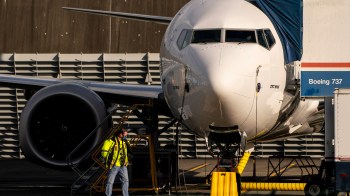Want to run the Iditarod? You’ll need a lot of scratch
Before musher Lance Mackey leaves a checkpoint in a race, he greets every dog on his team, with a scratch behind the ears, or a nuzzle. Mackey is the winningest musher in Alaska’s long-distance sled dog racing history, but he’s certainly not the richest.
Lance Mackey leaves a race checkpoint, driving a sled bedecked with the logos of sponsors that help finance his mushing career.
“Oh man, the cost is ridiculous,” he says.
It can take between $70,000 and $100,000 to keep a kennel full of racing dogs running year-round.
“[It’s] the price of fuel, price of dog food, entry fees all that stuff isn’t normally justifiable by racing for first place of $25,000,” says Mackey.
This year’s first place Iditarod finisher wins 70-thousand dollars and a brand new pickup truck. The first prize in Alaska’s ‘other’ 1000-mile sled dog race, the Yukon Quest, is less than half that, and there’s no truck. Mackey says prize money barely covers the cost of the race and expenses throughout the season, so he relies heavily on sponsorships to get his team to the start line.
“I have a new dog food company from Italy of all places,” says Mackey.
That sponsor’s logo is sewn on his sled bag and all the coats his dogs wear. Some mushers are sponsored by major international companies. Others make deals with small local businesses, but Mackey knows those relationships are often short-lived.
“Sponsors are not only hard to come by they are hard to keep,” he says.
That’s why some mushers, like Rob Cooke, also work a second job. He runs boisterous Siberian huskies. They’re also a slower breed, unlikely to win any big races. So, when Cooke isn’t training them, he works as a qualified aircraft engineer in the Canadian Yukon. “There’s that old quote that ‘It’s as expensive as cocaine, but a lot more addictive,’” says Cooke.
“I think that’s the truth. It’s so much fun, and it has to be worth it if you sit and think about how much money we do spend on this,” he says.
So how much money does Cooke spend?
“The meat costs for the race season was about $5,000. A new sled was about $3000, so yeah, I don’t want to think about it,” he laughs.
Four-time Iditarod Champion Jeff King used to own more than 100 dogs. Now he works with 35. “The dogs need to eat and be cared for every day: Vet bills, vaccinations and equipment … anything that is remotely disposable about our income goes into dogs,” says King.
Thirty years ago, a bag of dog food used to cost about nine dollars. These days, high-quality kibble can cost up to $60 a bag and it only lasts for two days.
This may be the last season of competitive long distance mushing for French Canadian Normand Casavant, known as the singing musher. And while he may be singing, he’s also broke. “I don’t know how I did that, but now it’s time to change. The thing is I need to bring money in now with my dogs,” says Casavant.
He wants to replace his tourism business with a mushing school, where he’ll start training the next generation of long-distance mushers, but it’s not clear if he’ll include a class on how to finance a dog team.
There’s a lot happening in the world. Through it all, Marketplace is here for you.
You rely on Marketplace to break down the world’s events and tell you how it affects you in a fact-based, approachable way. We rely on your financial support to keep making that possible.
Your donation today powers the independent journalism that you rely on. For just $5/month, you can help sustain Marketplace so we can keep reporting on the things that matter to you.


















